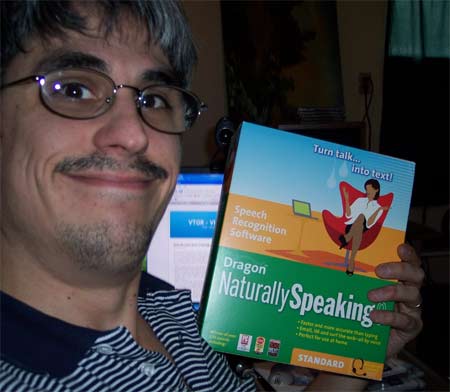
Maybe I’m a late bloomer, but I haven’t used PC or Mac speech recognition since 1998. I remember strapping on a headset and telling Microsoft Word 98 to write “I like corn.” The result was something like “I lake crone,” which was close enough given the power of my PC but still fairly useless in terms of getting any real work done. I know I’m not alone in saying that I shelved the entire concept.
Fast forward to about two years ago. One of the guys I used to work with, Charlie White, was amazingly fast writer. He could churn out page after page of text in a few hours, writing thousands of words a week. I asked him how he did it and he said “speech recognition.” Holy crap, right? Where were his typos? Where was the “I lake crone?”
![]()
Speech recognition has blossomed in the intervening years and I’m glad to say that I now use it about 20 percent of the time for longer form work. I use MacSpeech Dictate on my Mac Pro and have used it less on the MacBook Pro simply because you look kind of weird on an airplane talking to your laptop. The Windows analog is Dragon Naturally Speaking 9 which uses the same technology found in MacSpeech. There are a few other products out there but these are the two I can recommend. Windows even has speech recognition built-in, as does OSX, but these are focused on mundane tasks like controlling your computer with speech.

This guy seems to like it.
What can modern speech recognition do? It can translate your speech almost verbatim, with a few caveats. First, you have to teach the programs to recognize your voice, which is trivial. The training period can take about an hour so you might want to grab a drink before you start. It basically “reads” your voice and begins to map sounds to text. The texts are usually descriptions of the technology and how it can help you, so you’re learning something as you train the machine.
Once you’re done training your software, you can begin speaking directly to Word or your favorite word processor. Most recognition is clean and clear — you do have to watch what you type, but not any more than you already do when writing by keyboard. In fact, it makes you focus more on the content rather than what you want to type next. I can’t quite explain the cognitive differences, but speaking is more immediate and typing obviously requires more concentration. Being able to say things on the fly is empowering.
Now for the bad part. Adding punctuation is a bit iffy at points and there are times when requesting a period or comma gets you the word “period” or “comma.” This is reparable through training, but it’s a bit of a sticking point when you start out. Saying “Scratch that” to the software deletes a good chunk of text, approximately the chunk that you just spoke. Sometimes, however, it can delete too much and you have to redo the typing or do it manually.
On the whole I’m able to write more, if not better, using speech recognition. Is it for everyone? Sure. It works and it has advanced far beyond the “I lake crone” days. It definitely makes you productive. Just ask Charlie of the 10,000 word articles. He would never be able to produce the content he does without it.
I know you’re wondering if I used speech recognition to write this article? No, but not because I didn’t want to — I just didn’t install the software on this machine yet. It’s such a cool technology that I actually miss it.